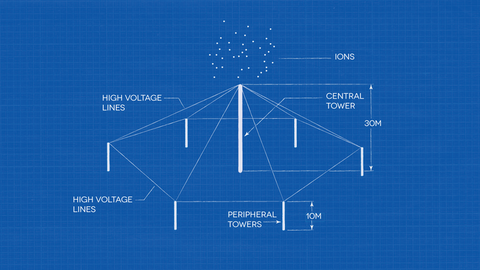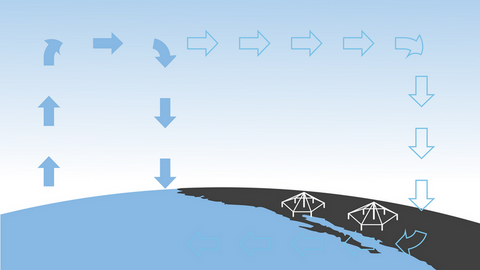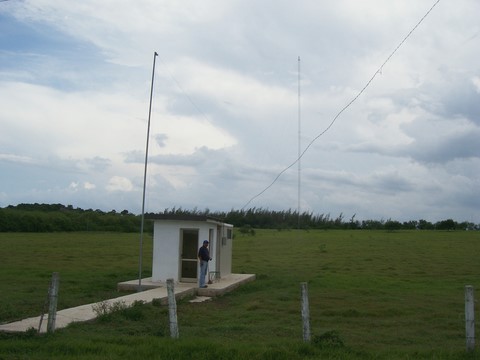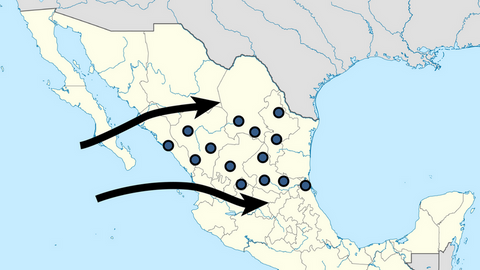Drought-control and weather-management through ionization systems
by Sergey Pulinets
We know Prof. Sergey Pulinets a.o. from his work on Ionospheric Precursors of Earthquakes, and Fukushima: Remote diagnostic of radioactive pollution of the atmosphere. Benjamin Deniston, of the LaRouche PAC Scientific Research Team, conducted with him in May 2015, from Moscow, over Google Hangouts, an interview on how his work on earthquake precursors brought him to a closer understanding of the role of the paramount role of atmospheric ionization on Earth's weather, and particularly on precipitation, and on harnessing the power of ionization to locally increase atmospheric precipitation such as in drought-stricken areas like California.
We are bringing here the highlights of this interview.
Sergey Pulinets
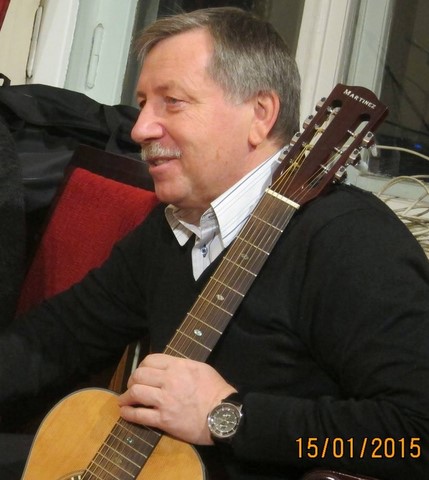
Sergey Pulinets is Head of the Moscow Center of Ionosphere Monitoring, at the Fiodorov Institute of Applied Geophysics.
He specializes in Space Plasma Physics, Physics of the Ionosphere, and Geophysics. He is the leader of an international team of scientists proposing the Lithosphere-Atmosphere-Ionosphere coupling concept related to seismo-tectonics, active faulting and earthquake processes.
His fields are: Space plasma electrodynamics, High Frequency radio-spectroscopy of the space plasma, Ionosphere physics and modeling, Lithosphere-Atmosphere-Ionosphere Coupling, Atmospheric electricity.
He also sings...:
Ionization
(.../...)
Hello Ben, hello to everybody. I would like to clarify a little bit the situation. Actually, my background is in space physics. And [my involvement] started from the end of the '90s, when we started to learn about the effects in the ionosphere that are associated with earthquakes. It was very interesting how the information from the ground, and even underground penetrates to our space, and I started to develop a theory about this. And to do this I had to be involved in geophysics, in solid geophysics: What happens before the earthquakes.
And for the first time, I encountered the problem of the ionization which is created by radon emanating from the Earth's crust, and the increase of this emanation before earthquakes. Radon can produce the ionization of air near the ground surface, and then, this heat propagates up to the upper layers of the atmosphere, up to the tropopause.
Another thing is the effects of cosmic rays. Probably you know that the clouds which cover our planet, to a great extent, are formed due to galactic cosmic rays, which produce ionization and then the ions become the centers of water vapor condensation, and nucleation and formation of drops and clouds, which we see every day; and there is a correlation between the cloud coverage of our planet and the variations of the fluxes of cosmic rays.
So nature gives us the answer, that ionization can produce the nucleation. We have these examples from space, galactic cosmic rays, and from the ground, from the nature of radioactivity; and we can see, for example, the results of studies of Japanese scientists, who, through the discharge from the needle, created the flux of ions and put them in the mass spectrometer, and were able to see how the particles grow.
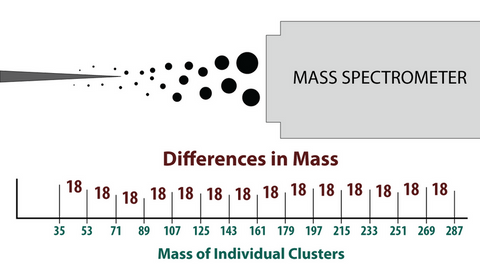
And if you look at the picture, you will see the distance between the sequential spectrum lines: In atomic mass, it is 18: It is the atomic mass of the water molecule. And you see how the ions gain more and more and more water molecules, and it was proved experimentally. So this is, let's say, the theoretical background, how the ionization can produce the large clusters, where in the center we have the ion and the envelope from the water molecules.
Mexico's ELAT
I came to Mexico and was working in the Institute of Geophysics of UNAM [National Autonomous University of Mexico]—the greatest university in Mexico City—working on the problem of earthquakes, but there I met some friends who made me familiar with a Mexican company named ELAT, which made experiments with the stimulation of rain. They had contracts with the governments of different states, especially in the drought areas of Mexico, such as in the Sonora desert, to produce rain to increase the harvest in these areas.
It is very interesting that the main idea, and maybe the ideology, was also proposed by a Russian scientist, Lev Pokhmelnykh, who was the founder of this company, and was supported by Mexican businessmen, and primarily by the Mayor of Mexico City. And because the physical mechanism is the same, simply the sources of ionization are different: We have radon before earthquakes; and they have a special installation which produces artificial ionization. So we started to cooperate.
After that, I became a member of the scientific committee of representatives of the Mexican meteorological agency scientists working in the physics of atmosphere; there was one scientist from the United States. (...)
So, how does this installation look? It is an iron mast of nearly 30 meters, from which, like rays, very thin wires go. Why very thin? We know that if we take the needle, for example, before the thunderstorm, when we have high voltage, high electric field in the atmosphere, we sometimes can see the discharge from the needle. So now, let us imagine that we have the ends of the needle connected to the thin wire, and the smaller the diameter of this wire, the more effective is the growth of the coronal discharge, by putting the higher electrical voltage on this wire.
So you create something like an "umbrella" around this mast, and you have shorter peripheral masts around the umbrella's circumference. So you have this installation, and the higher voltage which produces the ionization of air; and then, if you put positive or negative potential on this installation, with this electric field—for example, if you put positive potential, the positive ions will be moved by the electric field up to the upper layers; and moving to the upper layers, they gain more and more water molecules and become nuclei to form clouds.
Actually, for example, we can see these effects even before earthquakes, when the linear clouds are formed, over the tectonic faults. And this effect is observed everywhere and reported by many scientists. This is the same effect of the electric field, of the ions produced by the ionization by radon, going up, and forming the linear clouds over the active tectonic fault.
This is the explanation of this technology. Of course, the physics stands behind this, but I should underline one very important thing: We know the technology of so-called cloud-seeding, when, from an airplane, you disperse, for example, silver iodide, or you can even disperse cement, because any dust or aerosols in the air, become the center of condensation, and you stimulate the precipitation of rain.
But the difference between these two technologies is the following: By seeding, you can precipitate only the water which already exists in the air; you can create nothing more. But here, you create the new nucleus, and you take the water vapor and collect it into drops. And if you put your installation near the seashore—for example, in California, you can very easily put this installation near the shore—you can collect the humidity and then transport it, because you can put the different potentials between two installations. This creates movement of this air, filled by [these nuclei] for the formation of clouds inland.
Creating precipitation
So actually, if we are now speaking of the technology, you can take water from the ocean, to move inland and then create precipitation. To create precipitation, you need to create some conditions, relationships between the temperature at the altitude of the clouds and the dew temperature.
So, you should have your temperature lower than the dew temperature, to condense; this creates the drops, and creates the kind of instability which, in nature, we have in thunderstorms.
Actually, all people, and sometimes physicists who study the atmosphere, think in terms of hydrodynamics. For example, describing typhoons, hurricanes, they look only at the hydrodynamic mechanical movement, but they forget that we are living in an electrical world: there is a huge electrical potential on the top of the hurricane.
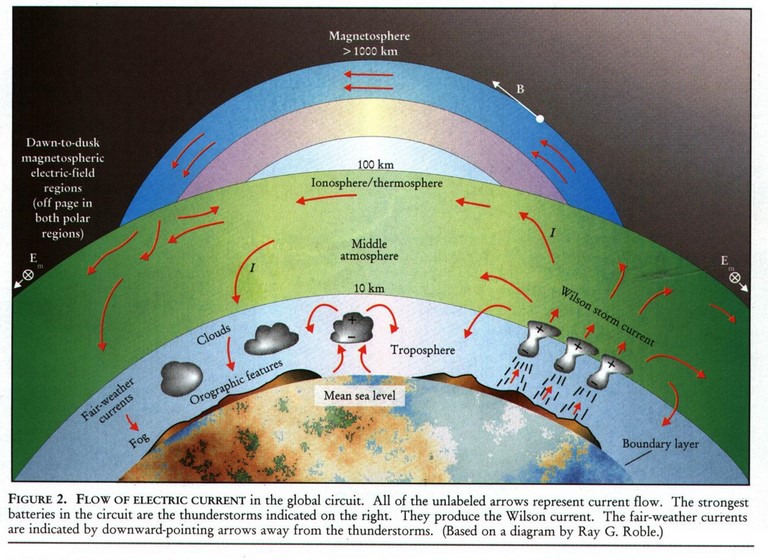
We live in the constant electric field which exists between the ionosphere and the ground; the potential difference between the ionosphere and the ground is near 250 kilovolts, and sometimes it can gain 400-500 kilovolts. And on the ground surface, the vertical gradient of the electric field is 100 or 150 volts per meter. You're a tall guy, so between your legs and your head, you have a 200-volt potential difference all the time!
This potential difference is created by thunderstorm activity globally. Thunderstorms charge the ionosphere positively in relation to the Earth, and in areas of fair weather, we have the return—the fair-weather current, which is very low, but nevertheless, we have a closed electric circuit, which is called, in science, the "global electric circuit". And simply, we use everything that is given to us by nature, helping a little bit with this ionization to create additional centers of nucleation.
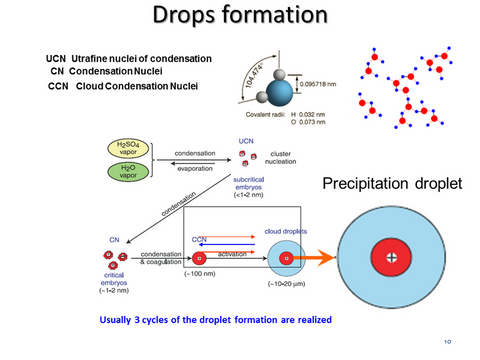
Now, there exists a conception in science which is named "ion-induced nucleation," which is explosive nucleation in the presence of the source of the ionization. So you can produce these centers of condensation, and your task is to transport it to the altitude of cloud formation, and then create the conditions to precipitate this.
Ion hydration
Deniston: Just to clarify for our audience here, let's take a couple of steps back: You're saying, we start with the fact that on the one side, there's already a lot of water vapor, evaporated water in the atmosphere...
Pulinets: Yes.
Deniston: So on the one side, with these ionization systems, you can create the conditions which accelerate or increase the rate at which that evaporated water condenses and forms liquid droplets, which can help...
Pulinets: The initial state is not droplets yet, but nucleation centers. They are too small to call them droplets. It is a complex process, from the ion to a larger particle, to the ion cluster, then nucleation, and then the droplet. The same process as formation of clouds in natural conditions: Simply, you form nuclei near the ground surface, and then transport them up with an electric field.
Deniston: And you had said that Japanese scientists have done experiments demonstrating the role of increased ionization in facilitating this process.
Pulinets: Yes. Yes, they published several papers, and I can provide you these publications with the figures, showing how these particles grow. It is very interesting.
I should also underline, that, contrary to the pure condensation, which needs saturated water vapor, 100% humidity, pure water, to have condensation, this process is called "ion hydration," attachment of the water molecules to the ion. And you can see from their pictures that this process takes place in any level of relative humidity, even if you have 25% humidity, you still will have the formation of these ion clusters with attached water molecules. Of course, the higher the humidity, the more effective the process we have, the larger the particles are formed. But in general, hydration takes place at any level of humidity. Even in low humidity conditions, you can create large particles and precipitate them in the form of dew, for example.
And for the plants, it doesn't matter whether you have rain or if you have dew; they can gain water even from dew.
Inducing water from the ocean
Deniston: You had also said, in addition to helping to induce what atmospheric moisture is there to come down, either to precipitate or to form as dew, you can also induce more flows of moisture to come in from over the ocean, you can actually increase the water availability in the atmosphere, too.
Pulinets: Yes. And I provided you the pictures from the Mexican experiments: You see the line of installations, perpendicular to the shore, starting from the Pacific, and this line helped to move the mass of air filled with the humidity inland in Mexico.
Deniston: And so, you had said, based on your work, these systems in Mexico have shown some pretty impressive results.
Pulinets: Yes. You can see there, the results of the filling of dams [reservoirs—ed.] of the hydroelectric power plants. And there were three dams, and there are results for one and a half years, and you can see how these dams were filled up with this technology. Actually, they also tried to fight forest fires in the Yucatan Peninsula, creating artificial rain, to fight forest fires.
Deniston: And they also had success in doing that?
Pulinets: Yes, there are some statistical results showing the occurrence of forest fires during the period of the activity. You may have something like 20-30% increase of precipitation—not that you create heavy rains, you see, but you can increase, in an essential manner, the amount of water precipitated.
Deniston: Maybe to step back also—you had said early on that this is very similar to what occurs naturally with the radiation coming in from the galactic system. And I think we could take a few minutes to discuss that, because that is a relatively a new area of study, where we're starting to learn and understand the effects of what the Sun is doing, and then also, the effects of the high-energy radiation from the galaxy, are actually a constant input shaping the environment of the atmosphere, affecting climate, weather (...) Can you say more about that?
Pulinets: Yes. Any particle with energy—the energy of ionization of molecules of air which is from 10-15 electron volts—so any particles which have energy higher than this energy, can ionize a water molecule. If we talk about the cosmic sources of ionization, we have two main sources: There is our star, the Sun; and the galactic cosmic rays, which have much higher energy. And the altitude of penetration of these particles into the atmosphere depends on the energy of the particles. The solar particles have lower energy, so they cannot actually penetrate to the lower layers of the atmosphere, and they lose their energy at altitudes, say, from tens to hundreds kilometers: This is the source of the Northern Lights. They excite the molecules, and atoms, actually—at these altitudes we are now speaking about atoms of oxygen and nitrogen, and we see the green and red lines of the polar lights.
But the galactic cosmic rays, which have much higher energy, have the altitude peak where they lose their main energy, at the altitude of the tropopause, which is from 10-15 km. This is the altitude of the top of the clouds of our atmosphere. So these are the layers where the clouds are formed, and the first good statistical results were made by [Henrik] Svensmark; he is a Danish scientist, who showed that during two cycles of the Sun's activity, 22 years, the cross-correlation coefficient was near 95% between the variations of the galactic cosmic rays' fluxes and the cloud coverage of our planet.
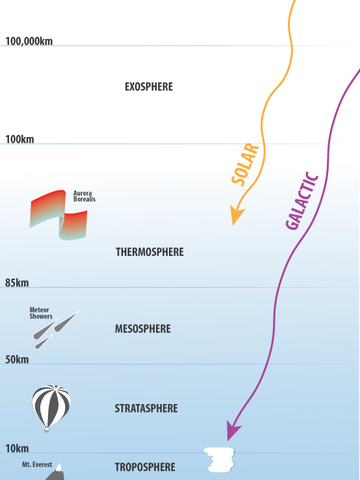
And now this theory has been developed very well, showing how the primary ions are formed; then they enter into the chemical reaction, create the final ions, and these final ions become hydrated and form the nucleus of clouds.
So this theory is well-developed, and probably you have heard of a large—huge, you can say!—chamber created at CERN, in Switzerland, where they studied this process of cloud formation. But they spent a lot of money, and I prefer the experiment of the Japanese, which is a very simple one, very clever, showing this process very clearly.
And what is very interesting, is that sometimes physicists who are working in this field do not take into account another effect connected to this ionization: the release of latent heat. You know that water molecules free in the air, with the air existing as a gas, and water molecules in water, have different energies. Water can exist in three phases: It is gas, liquid, and solid. So, water vapor, water that we drink, and ice. And between them, there is a difference in the energy of the water molecules which we do not see; that's why we call it "latent heat".
So, for example, to evaporate—you know, this is a proverb, that "a watched pot will never boil." Because it seems that you have reached 100° centigrade temperature, but you wait and wait and wait until the vapor starts to be emitted from the water. This is the period when the water molecules gain this latent heat to evaporate, to become free from the water. And we have a backward [reverse—ed.] process: When the water is condensed, it releases heat into the environment.
So that's why, in Asian countries, we see a lot of hot fountains—and probably also you have the special water systems in California—because water from fountains starts to evaporate, and it absorbs the heat and decreases the temperature in this area. That's why we create fountains: To decrease the temperature a little bit, where we have a hot climate.
And so, if we deal with ionization, we have the same effect. When the water condenses on ions, it releases heat. But if you decrease the condensation, you will decrease the temperature in this place. That's why it was discovered, the connection of the sharp decrease of galactic cosmic ray fluxes during the magnetic storms, with formation of the hurricanes.
Again, in Mexico, I have a good colleague, Jorge Pérez-Peraza, who is working on the connection of the fluxes of galactic cosmic rays and formation of hurricanes in the Atlantic and Pacific areas of Mexico. And he has very good statistics, that show that when you have a lot of Forbush decrease—so, an active Sun, many magnetic storms—this increases the probability of the formation of tropical cyclones and hurricanes.
And we published a paper showing the physical mechanisms: If you have a decrease of fluxes of galactic cosmic rays, you decrease the temperature on the level of the tropopause, and in such a way, you increase the temperature difference between the surface of the ocean and the tropopause. So, you sharply increase convection and help hurricanes to form, due to increased convection.
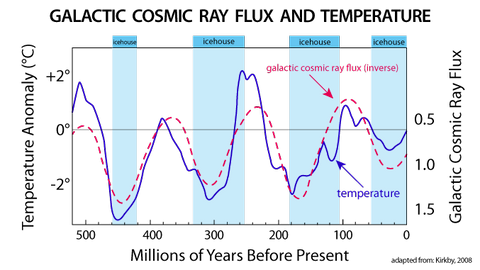
Galactic cosmic rays
Deniston: I think this is a remarkable thing you're saying, that these high-energy particles, not coming from our Earth, not coming from our star, but coming from all regions of interstellar space and the galaxy, are actually playing an active role in things like the strength of hurricanes or hurricane formation.
Pulinets: Yes, yes, yes. And there is—Pérez-Peraza discovered another effect of modulation of fluxes of galactic cosmic rays, with periods of Earth ice ages in the long-term history of our planet. And they were able to demonstrate that it could be—this is hypothesis—could be connected with movement of the Solar System in the arms our spiral galaxy. And when the Solar System is inside the arms, that is, there is more dust, so there is less flux of the galactic cosmic rays. And between the arms, we have the larger fluxes of the galactic cosmic rays. And these periods coincide, temporally, with periods of increased and decreased temperature of our planet.

Deniston: All these ionization effects, these cosmic radiation effects that you're describing here, they're constantly creating certain conditions in our atmosphere that affect how water vapor behaves, that affect how weather behaves, that affect climate.
Pulinets: Yes, and we should not forget that with clouds, you have the shadows on the Earth. So the temperature variation is connected not only with the direct heat created by cosmic rays, but with the shadow: More clouds, more shadow; fewer clouds, you are open to the Sun. So these variations of temperature connected with shadow are also essential.
Deniston: Well, I just have to say, this kind of redefines what we mean when we think of the Earth's climate, because it's not—it's more like a solar and galactic climate than just an Earth climate.
Pulinets: We should take into account both of them. You see, you cannot say that it is only galactic. But the galaxy creates some contribution to the variations of climate.
Deniston: Mm-hmm. And so you're saying that this work being done with these ionization systems, is a way that we can begin to affect these types of parameters, create our own influence on these weather systems, the water cycle, and utilize that to our own benefit.
Pulinets: Yes, I think so. It is possible, but we should do it, very, very carefully. I suppose that there should be state or administrative control, because influencing the environment could be dangerous; you should have some limits, because you can create huge installations to make very large ionization, depending on the polarity; then you can increase the number of clouds, or decrease the number of clouds. Somebody will want to have a resort and have a lot of Sun; another one wants to produce grapes and have rains, and they could be neighbors, and then fight over whether you have clouds or don't have clouds! So these activities should be regulated, of course.
Deniston: What would you think should be the next step for developing these systems, as you're saying, in a mature and regulated way? Because I think this opens up a whole new potential, obviously for how mankind can deal with these challenges, like droughts, or like bad weather occurring that causes excess flooding. (...)
Responsible water management
Pulinets: I suppose we should organize open and clear, distinct experiments on this, with good scientific support, for scientists to be able to control and to see that such effects really exist. Because, let's say, traditional atmospheric scientists or meteorologists sometimes say it's not possible; so we should at least make these experiments, to demonstrate, first, to the scientific community, and second, to the public, that no danger exists. These effects are no more dangerous than a natural electric field.
I know that in some experiments in Mexico, the cows came close to this installation, because they have a better feeling inside this electric field! So, this is a proof, that it is no danger to nature. And the birds feel these electric fields very well, so they do not approach them.
Deniston: And maybe also, you've been mostly discussing the activity that went on in Mexico. There are other companies in other places where these systems have been demonstrated, correct?
Pulinets: Yes. I know that such companies exist in Saudi Arabia, maybe in Australia; maybe some are already in Russia, but they are not doing active experiments. I know that there were experiments on ionization in Japan, over five years. But they were not connected with rain, they were connected with dispersing fogs in the mountain roads of Japan. So you create precipitation and decrease the fog, to improve the movement in tunnels and high mountains, where the fog forms very often.
Deniston: How long do you think it would take to get a demonstration system set up, say, maybe in the region somewhere in California, to demonstrate the validity of this technology?
Pulinets: Actually to put up the installation takes one to two weeks, and I suppose we need at least one year to check different seasons, to see Winter, Autumn, Spring, Summer, where we have the optimum conditions to create favorable conditions for this precipitation. And we should take into account also the farmers' planting calendar, to also meet their needs, and so on—not only for drinking, but for agriculture, basically.
But it seems to me, one year will be enough to set up experiments.
(...)
Deniston: And you've said that your work in studying earthquake precursors and how the lithosphere, and the atmosphere, and the ionosphere interact in the preparation process for earthquakes—the theoretical framework you've developed in studying that—has very valid applications for this weather control as well.
Pulinets: Yes, of course. It is the same physical process, and even the same environment, because the installation is near the ground. So we have only the different sources of ionization.
Furthering international cooperation
Deniston: Well, I think this is a very exciting and important perspective that we're discussing here. And I also think, just because we're speaking now from the United States to Russia, this is also an important area where we can have productive and healthy international collaboration between our countries.
Pulinets: Yes, and of course, in the conditions we have today, it may help us to improve our relationships, which have gone down a little bit during the last year. But our cooperation, for example, in space, in the International Space Station, and in physics, etc., never depended on any conditions, but was very firm, was very frank, and I suppose we should maintain these relationships.
Deniston: It certainly seems like a key area, because we're defining how mankind can address problems that are bigger than any one nation: You know, a drought's not just an issue for one part of the world, and not the other. These are the types of things that all mankind should be thinking about.
Pulinets: Yes, of course. It is a global problem, and all nations should unite to improve the condition.
Deniston: Do you have anything else to add in conclusion? I really appreciate your taking the time to go through some of the science and your background in this area. I think it's very important.
Pulinets: And I also want to thank you, for finding me and giving me the opportunity to explain how we can fight the droughts. We don't need too much money for these installations. (...) For example, in comparison with the seeding from airplanes, this is moderately priced.
Deniston: Well, I thank you again for joining us, Professor Pulinets. It's always a pleasure to get a chance to speak to you and get your understanding of these things.
Pulinets: Thank you, Ben...
Full interview - including video - available at: Larouche PAC.
https://larouchepac.com/20150506/end-droughts-weather-control-interview-prof-pulinets
Weather control? Yes, it is really possible... by Sergey Pulinets
How it works
As far back as the 1920s, the great Russian naturalist Aleksandr Chizhevskiy pointed out the interaction between solar activity and various natural processes on Earth, including the weather. He also drew attention to the role of ions in the atmosphere and their ability to absorb moisture. Today, ionisers that purify the air can be found in many homes. The prototype for these was the so-called "Chizhevskiy chandelier", designed back in the twenties. This "chandelier" bore an outward resemblance to the lighting chandeliers that were common in those days, but instead of producing light, it emitted a stream of electrons which combined with oxygen molecules to form negatively charged oxygen ions.
Scientific developments at the end of the twentieth century also shed light on one of the mechanisms of the Sun's influence on the weather. The Russian scientists Pudovkin and Raspopov demonstrated the importance of the influence of galactic cosmic rays on the Earth's atmosphere and the role of solar activity in modulating the flow of rays reaching the atmosphere. At times of enhanced solar activity, the stronger solar wind and magnetic field in the Earth's magnetosphere have the effect of partially slowing and deflecting the flow of cosmic rays, while in years when the Sun is calm the flow of rays reaching the atmosphere is greater.
How do cosmic rays interact with the Earth's atmosphere? The high-energy protons, of which cosmic rays largely consist, ionise air molecules. The ions produced become centres of water vapour condensation. The molecular clusters grow by attracting increasing numbers of water molecules, as a result of which clouds form. The heavier the cloud cover, the less direct solar radiation reaches the Earth's surface, and the less cool it is at the surface. Danish scientists have demonstrated a 95 pc correlation between the area of global cloud cover and the variation in flow of galactic cosmic rays.
Of course, there can also be artificial sources of atmospheric ionisation. Chizhevskiy showed that fine metal spikes supplied with a high electrical potential can be very efficient ionisers.
This idea was taken up by the Russian physicist Lev Pokhmelnykh, who created appliances that could generate ion streams over large areas.
The appliances
A very fine wire can be imagined as a combination of a very large number of points. The longer the wire, the more intensive is the stream of ions entering the atmosphere and the more efficient is the appliance. There are various ways of designing the appliance itself, but the main objective is to increase the area generating ions. A high electrical potential is applied to the wire, which can be lower or higher than the potential of the corona discharge. This potential causes the ions of that sign to rise from its surface. As already noted, the ions are centres of water vapour condensation. As they rise under the influence of the electrical field, they grow to the size of embryonic drops, which eventually leads to the formation of clouds at an altitude of several kilometres. Depending on the sign and scale of the potential, this process can be accelerated or decelerated, and it is also possible to "disperse" the clouds, thereby creating cloudless weather. The processes of condensation and evaporation cause heat to be emitted or absorbed, which means it is possible to artificially change the temperature, including inside a cloud, bringing it to "dew point" and inducing precipitation.
When a high electrical potential is applied to the appliance's wires it makes the ions move upwards, away from its surface. Along the way, the ions pick up molecules of water vapour, which leads to the formation of clouds at an altitude of several kilometres. Additional adjustments to the appliance's potential even make it possible to change the temperature of "dew point" within the cloud and to instigate precipitation.
Proven in practice
The theory has not remained simply a theory. The Russian physicist succeeded in practically proving its effectiveness. After moving to Mexico, Pokhmelnykh set up a company that over a period of more than 10 years successfully influenced the weather and the climate with the aid of these appliances. In particular, artificial rainfall was induced in dry regions of northern Mexico, which led to an increase in agricultural productivity.
The technology proved to be so effective that in the past two years it has been used to put out fires over large areas in the Yucatan peninsula at the request of the government of Mexico.
Pokhmelnykh's former colleagues in Russia did not forget what he had taught them, and over a number of years the technology was applied in the Krasnodar region, resulting in increased harvests.
Areas of influence
The process can also be applied in a different direction. In the event of intense rainfall, reducing the quantity of ions in the atmosphere makes it possible to disperse the clouds - and this is what ionising appliances can do.
Consider the disastrous fires in California or Australia. If these appliances had been available there, although it might not be possible to extinguish the fires completely, artificial rain could have significantly weakened the scale of casualties and physical damage. Conversely, in the event of floods due to intense rainfall, it would be possible to substantially reduce the precipitation that caused the floods.
One further area of use for this technology is purifying the air in polluted cities. Radiation from special antennae can change the electrical charge in the atmosphere, thereby filling it with ions and killing microbes.
Let's dream
At the beginning of this article we talked about a mild effect on the weather by means of regulated ionisation. So what does this mean? Very often countries that rely on agricultural produce for the bulk of their national product, such as India, find themselves hostage to the whims of the weather. Protracted rains during the period when crops are ripening, or drought during the vegetation period, can often lead to humanitarian disasters and leave whole areas of the country with no harvest. These appliances can help make the weather less capricious by "prompting" the right levels and periods of rain and sunny weather. This kind of regulation will make it possible to achieve guaranteed harvests.
Sergey Pulinets
Article published in Russia Beyond the Headlines, March 25th, 2009.
Go to original article


